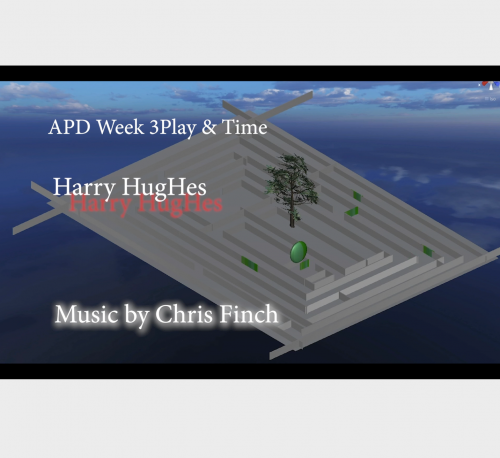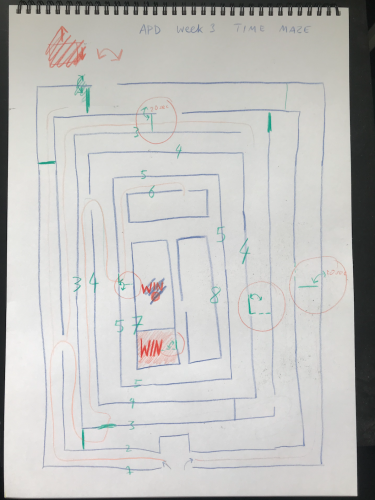Context
This week’s theme was Play & Time and I persevered with my desire to make a new game every week in this class, and learned some new things along the way.
After the initial excitement of starting a new semester and rediscovering motivation, I was just starting to feel slightly burnt out when I approached this new game. I did a pretty hard brainstorm and decided on making a maze, partly because I had just watched The Shining which has an excellent hedge maze sequence. I had also been thinking about how game makers use time, and especially reflected on the idea that in some games, the gameworld elements are usually on loops, and the player is asked to study these loops in order to make sense of what is going on. Through doing so, “when” the player does something becomes as important as “where” (see reference below).
One of the first thoughts to appear from my brainstorm was that I could make a maze with doors that open and close on timers. I thought that by doing this, players would need to not only study the map, but figure out when certain paths might be open to them, and know that they need to study and plan in order to get towards a certain goal before the timer runs down.
I spent a long time designing and then building the map which was quite fun but at the end of it the game was simply not very interesting, and didn't actually require any studying of the map because players could either get lost or encounter a door and simply wait for it to open. Dispirited I stepped away for an hour or so, and realised in that time that the part I liked most about the game was watching the scene play out from above, just watching the green doors open and close- an mesmerising loop video that reminded me of watching NPCs operate in the Hitman games (a series that involves a lot of waiting and planning- and I decided to persevere with the project from a slightly different angle. Though last week I was vehemently opposed to having any superficial elements in my games, I was witnessing a triumphant return to pointless fun, adding a spinning sphere and a tree.
As a lucky accident, I made the key light in the scene- which had essentially been operating as sunlight- spin around in a simple keyframe animation. Though I was ready for this game to become simply a video art project, I found that when I clicked back into the game, the revolving sun made everything much more interesting, and did add a very real sense of urgency, evoking surveillance and the passing of time.
I then also made the player move at a ridiculously high speed, and found the game was a whole lot more fun. So suddenly I had a cool video AND a vaguely interesting game that was “on theme”.
Method
A 3D game made in Unity and a short video piece made in Unity.
Response
Still waiting for feedback.
Reflection
It really wasn’t until I stepped away from the planning and building phases of this project that I realised there was a way I could come back and make it interesting. I had to sort of remind myself that even though I’m trying this semester to make my games better quality and more involved technically and programmatically, I will never not be interested in deeply weird and funny projects. It’s pretty easy to think up an idea for a game to get you going- “build a maze with moving doors that you need to study in order to get through before a timer runs out”- but it requires a different part of your brain to look at that game you’ve been building and decide “it’s better to have no countdown timer, no goals, and no explanation”. I guess a lesson here is that it’s good to sort of rush and not overthink, just make something that pops into your head and have faith that you’ll be able to make it interesting later (which is admittedly something I have to remind myself of constantly). Indeed if I had thought too far ahead, I may have never convinced myself to just build the maze, and later the fact that I had the maze built meant I could do so much with it, even if it wasn't following the original plan. Build your maze!
In terms of the theme, I really do think I learnt a lot about the role of time in the game, though time is never explicitly referred to. The juxtaposition between the high speed of the player, and the slowness of the doors is quite jarring and creates tension. The looping video of the doors opening and closing is hypnotic. And the revolving sunlight also invokes time and urgency; I feel like the game is telling me I’m running out of time, or at least that “something is wrong and needs to be fixed”. But then perhaps seeing that there is no timer, and even when you get to the spinning sphere and the tree, nothing happens, the player comes to different conclusions about the type of project that this is.
I also thought about the personality of this world. The high walls, huge doors and extreme contrast in light make the space fairly unkind and alien.
I also can't not mention the music. A very good friend who is a very good musician lent me this piece and I think it suits the project perfectly. It rreally changed the way I saw everything, forcing me to slow down and take in what was going on, and vaguely reminded me of other sparse, slow-moving titles such a Ico.
Game: https://harry-hughes-rmit.itch.io/play-and-time-maze
References: A quote from the developers of game The Outer Wilds, a game in which multiple planets fly (on loops) around a solar system says: 'The fact that each planet irreversibly changes over the course of twenty minutes means that it is practically impossible to explore the entire solar system during a single plathrough.... This setup effectively adds an extra dimension to exploration by making "when"players explore just as important as "where."'. I know this from watching this excellent video on time in video games from Game Maker's Toolkit.
About This Work
By Harry Hughes
Email Harry Hughes
Published On: 24/03/2021

